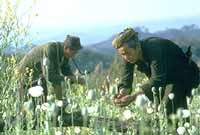
The Heroin Wars: 3 Parts 1996
Distributed by Bullfrog Films, PO Box 149, Oley, PA 19547; 800-543-FROG (3764)
Produced by Carlton UK Productions
Directed by Adrian Cowell
VHS, color, 3 hours
Adult
Sociology, Anthropology, Political Science
Date Entered: 11/09/2018
Reviewed by Gerald Notaro, University Librarian, Nelson Poynter Memorial Library, University of South Florida, St. PetersburgProving, again, that truth is far more intriguing than fiction, director/narrator Adrian Cowell's 3 part The Heroin Wars is documentary film making at its finest. Self described as, "Essential viewing for anyone interested in the history of the narcotics trade and the war on drugs," each part of the series stands on its own. Cowell and cameraman Chris Menges (The Killing Fields) began filming the saga in 1964.
Part One-The Opium Convoys opens with early footage of the Shan revolutionaries in the mountains of Burma. It is very reminiscent of Vietnam in the 60's, and of the cool detached coverage by the BBC: more fact, less propaganda. The revolutionaries quickly learn that to control the narcotics is to control the government and begin taxing the convoys. Bribes work wonders, and allegiances change quickly and often. A plot is hatched for the U.S. Government to purchase the Burmese narcotics to stop it from reaching the States. Filming goes all the way to the Carter White House staff meetings. Politics are in full gear, the results as comic as they are tragic.
Part Two-Smack City, takes the viewer from the jungle trails and into the world's opium center for over a century, Hong Kong. The Chinese culture had long tolerated opium use. Smoking opium was not very addictive, certainly less so than drinking alcohol. Passing out was the most destructive side effect. When the U.N. began cracking down on opium, dens were easily targeted by the police. Smugglers refined the opium into morphine and heroin because it became more concentrated, easier to hide, and its use was less detectable. The Chinese still smoked it, which prevented the spread of hepatitis more common in the West. When the large syndicates were crushed and heroin became scarce and expensive, injection became prevalent because a greater high could be attained with a lesser amount. As the risk in smuggling and selling rose, so did the price, increasing crime levels dramatically. Even police admit that the more the narcotics are regulated, the more crime occurs. Addicts are addicts. The cameras and story follows addicted traders from the early 70's through 1994. All are still addicted, or dead.
The saga, and series, concludes with Part Three - The Kings of Opium. Not a single convoy has been stopped or captured, even though they are now carrying 10 times the load of 30 years previous. The guerrillas control the Shan State and strongly oppose the Burmese government. The Opium Lords, of Kings of Opium, declare that drug trade and the Shan revolution will always be intertwined. The Burmese government, with the help of the U.S. government and its "war on the drug war," engage in full-out war with Shan Opium King Kuhn Sa. He holds his ground until another Opium King, Lo Hsing-Han, is brought back from prison by the Burmese government. Kuhn Sa resigns and gives up the territory to the Burmese. Instead of turning him over to the American government he and his soldiers are made militia to protect the drug routes. The American government is duped, again.
The Heroin Wars is a superb and skillfully told story which ultimately reveals that as long as there are supplies, and drug addicts, there will always be a drug trade. Highly recommended for purchase.